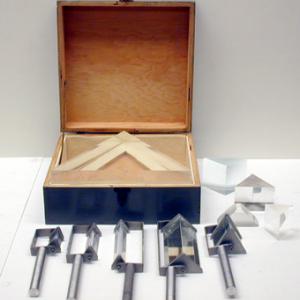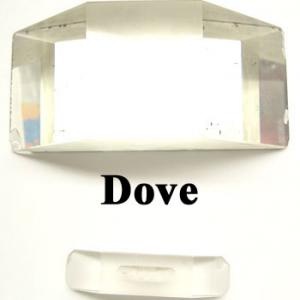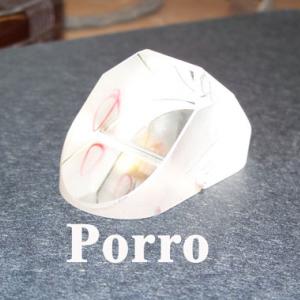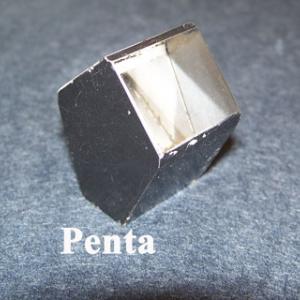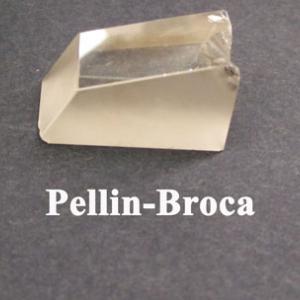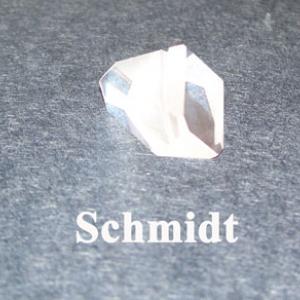College of Liberal Arts & Sciences
6A42.51 - Prisms - Prism Glasses
Also see Perception - Depth Perception at 6J11.60.
The prism glasses are designed using right angle prisms so that you can lay down flat on your back and still watch television.
The most common use for the prisms is to use them in conjunction with a white light projector to produce a rainbow spectrum. With the larger plastic prisms and a laser the angles of refraction and total internal reflection can be demonstrated.
Labeled pictures of some of the specialty prisms are also shown above.
- Jai Lucio Padros Ribeiro, "Bed Prism Spectacles", TPT, Vol. 54, #1, Jan. 2018, p. 18.
- Thomas B. Greenslade Jr., "Reflection by Porro Prisms", TPT, Vol. 48, #4, Apr. 2010, p. 240.
- T. A. McMath and Mario Glavacic, "A Fast and Accurate Technique with the Prism Spectrometer", TPT, Vol. 26, #7, Oct. 1988, p. 461.
- E. Scott Barr, "Letters: A Versatile Prism", TPT, Vol. 26, #1, Jan. 1988, p. 9.
- E. Scott Barr, "A Versatile Prism", TPT, Vol. 26, #1, Jan. 1988, p. 8.
- G. B. Friedmann, "Limits of Deviation by a Prism", AJP, Vol. 55, #12, Dec. 1987, p. 1139.
- N. Gauthier, "Wavelength Dependence of the Refractive Index", TPT, Vol. 25, #8, Nov. 1987, p. 502.
- Thomas B. Greenslade, Jr., "Porro's Prism", TPT, Vol. 25, #4, Apr. 1987, p. 228.
- Michael D. Edmiston, "Measuring Refraction Indices", TPT, Vol. 24, #3, Mar. 1986, p. 160.
- Earl Zwicker and Gerard Lietz, "The Sail-Cart: A Free Giveaway", TPT, Vol. 20, #9, Dec. 1982, p. 622.
- Frank S. Crawford, "Why is White Light Dispersed by a Prism?", TPT, Vol. 17, #9, Dec. 1979, p. 583.
- Dileep V. Sathe, "A New Method for the Refractive Index of a Prism", TPT, Vol. 16, #8, Nov. 1978, p. 560.
- Stephanie Taylor and Everett Hafner, "Turning a Perfect Corner", AJP, Vol. 47, #1, Jan. 1979, p. 113.
- S. Waldenstrom and K. Razi Naqvi, "A Simple Accurate Alternative to the Minimum-Deviation Method for the Determination of the Refractive Index of a Prism", AJP, Vol. 46, #10, Oct. 1978, p. 1009.
- E. Stanley, "Prism Goniometry by the Return Beam Method", AJP, Vol. 39, #5, May 1971, p. 576.
- Katie Peek, "Turn the World Upside Down", Popular Science, June 2015, p. 70.
- Of-1, 2, 3, 4, Om-7: Freier and Anderson, A Demonstration Handbook for Physics.
- Wallace A. Hilton, "G-1", Experiments in Optical Physics, p. 8.
- Wallace A. Hilton, "G-2", Experiments in Optical Physics, p. 10.
- George M. Hopkins, "Prisms", Experimental Science, p. 202.
- T. Kallard, "The Reversing (Dove) Prism", Exploring Laser Light, p. 33.
- Jearl Walker, "6.73, Rearview Mirror", The Flying Circus of Physics Ed. 2, p. 270.
- Gordon McComb, "Other Optical Components", Lasers, Ray Guns, & Light Cannons, p. 38 - 39.
- John H. Moore, Christopher C. Davis, and Michael A. Coplan, "Prisms", Building Scientific Apparatus 2nd Edition, p. 149 - 154.
- C. Harvey Palmer, "Experiment A4: Demonstration of the Redirective Properties of Prisms and Plane Mirror Devices", Optics - Experiments and Demonstrations, John Hopkins Press, 1962.
- Joseph Frick, "#166 - Prisms", Physical Technics: Or, Practical Instructions for Making Experiments in Physics and the Construction of Physical Apparatus with the Most Limited Means", p. 192.
Disclaimer: These demonstrations are provided only for illustrative use by persons affiliated with The University of Iowa and only under the direction of a trained instructor or physicist. The University of Iowa is not responsible for demonstrations performed by those using their own equipment or who choose to use this reference material for their own purpose. The demonstrations included here are within the public domain and can be found in materials contained in libraries, bookstores, and through electronic sources. Performing all or any portion of any of these demonstrations, with or without revisions not depicted here entails inherent risks. These risks include, without limitation, bodily injury (and possibly death), including risks to health that may be temporary or permanent and that may exacerbate a pre-existing medical condition; and property loss or damage. Anyone performing any part of these demonstrations, even with revisions, knowingly and voluntarily assumes all risks associated with them.
